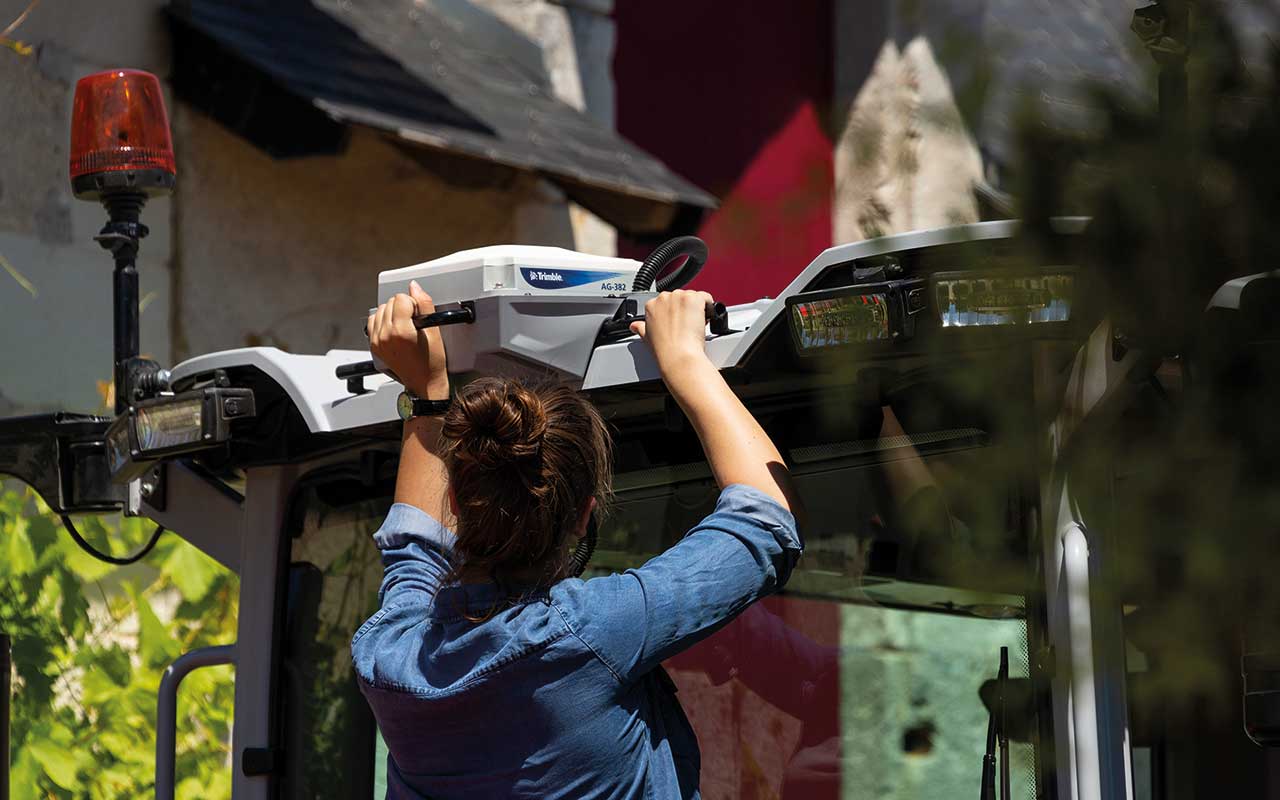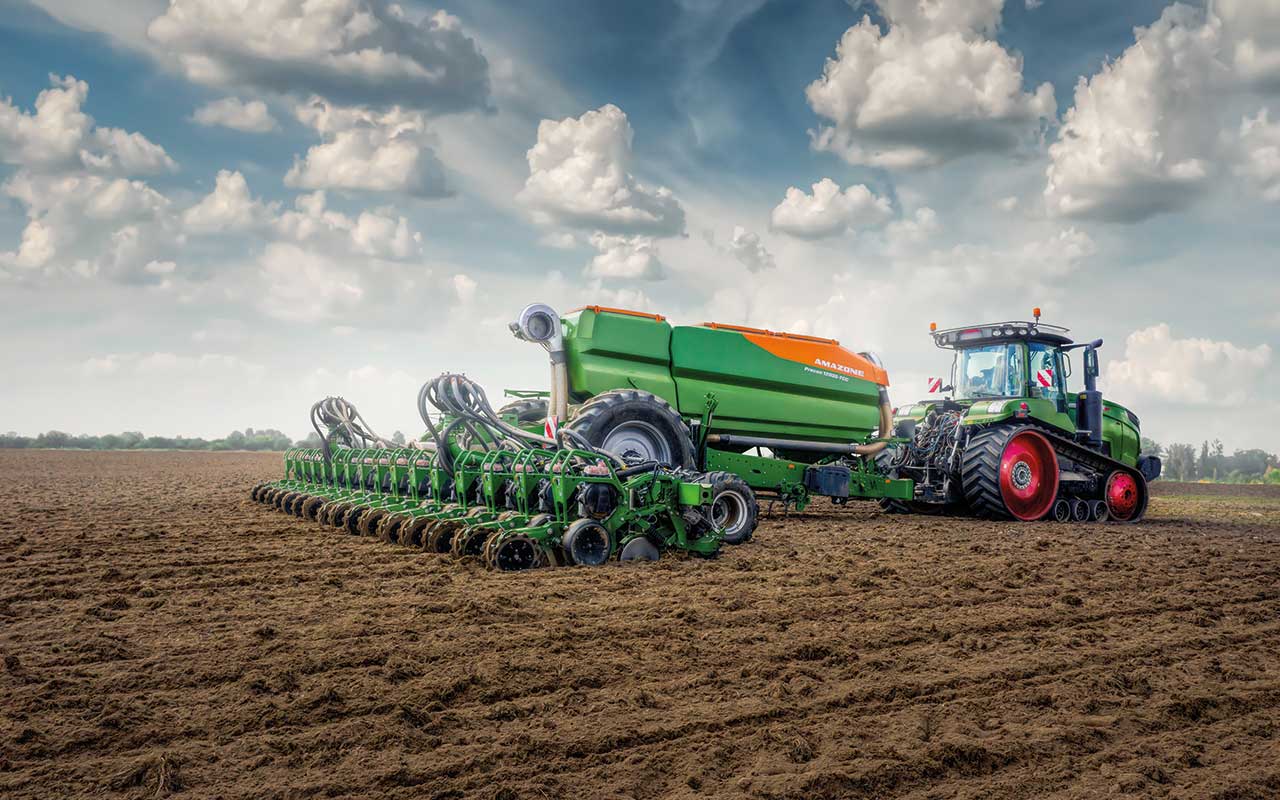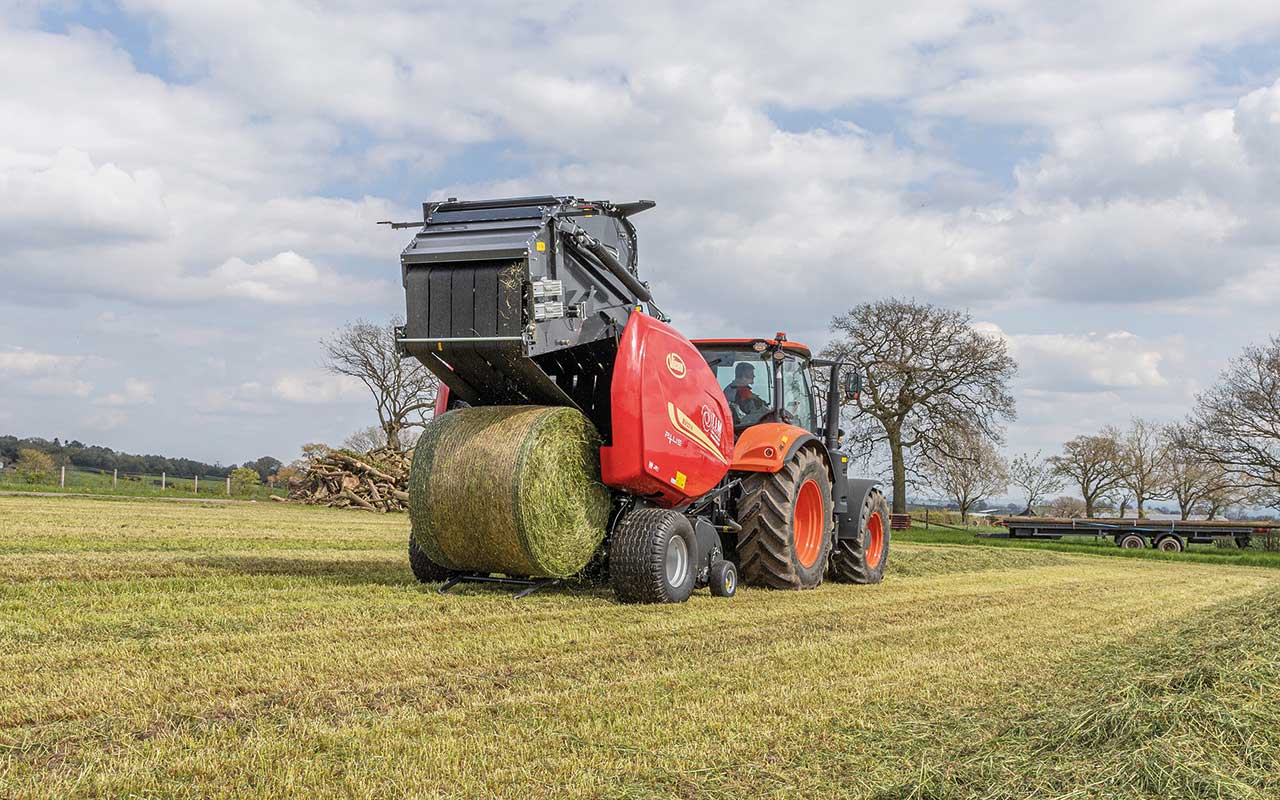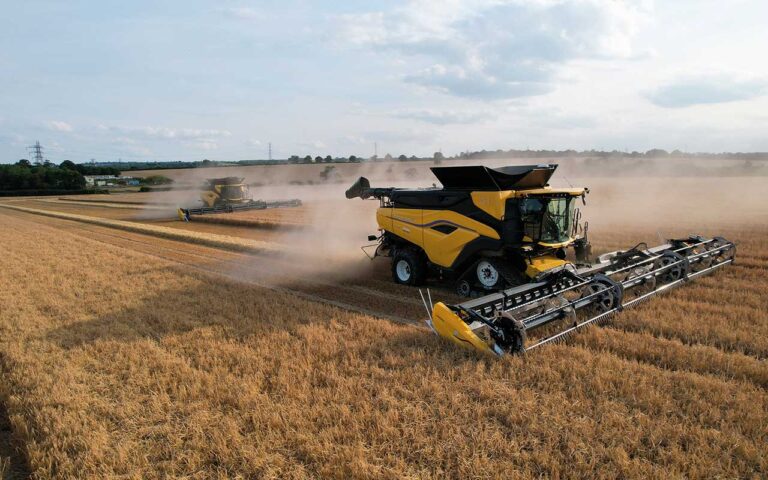PTx Trimble, a joint venture from Agco and Trimble, was set up to enhance the precision farming availability across the Agco range while also continuing to offer brand-agnostic systems. PTx Trimble’s Mick McCarthy says precision farming systems are designed to help growers get more from less.
“We’ve all seen the figures that show we will need to produce more food for a growing population, likely using less land and working in tighter windows due to extreme weather events,” he explains.
He adds that while the direction of travel appears to be towards complete automation, this will not be the end point, but instead it is a tool that will be used alongside technologies such as vision systems and smart implements.
“There are solutions coming that will build up implements, enabling them to work better alongside smart tractors. Camera technology is here and now, with systems to detect weeds, both on bare soil and in a growing crop.”
He also notes that adoption of these technologies is sometimes a limiting factor due to uncertainty about new methods of working and the initial price point.
However, Mick believes those who invest early will see many benefits.
“There’s an element of risk and reward, but those first adopters have the chance to reap huge rewards, not just through efficiency gains, but also through an increased quality of data that will inform decisions.”

Speaking to Topcon, another brand-agnostic supplier of precision farming equipment, Tim van der Leck explains that one of the key developments is precision farming systems, moving down from large-scale arable operations to utility and livestock businesses.
As an example, he points to the TAP Feed solution, which links to a mixer wagon to accurately monitor livestock rations and reduce waste.
He says one of the biggest challenges is how to communicate the benefits of the systems to growers.
“I think the industry has occasionally been guilty of selling hardware based on the benefits to the operator, rather than what businesses should be looking at; return on investment.
“We need to focus on real-world testing and validated figures to show how quickly these systems can pay for themselves,” Tim explains.
“Looking at TAP Feed, we have data that suggests the basic version could bring a return in less than a month, while the more advanced system takes slightly longer. That’s not just ease-of-use benefits, it’s money in the pocket of customers.”
Looking ahead, he points out that in many ways we have already reached autonomy. “Tractors can steer themselves, stop at the headlands and perform turning manoeuvres,” he says.
“But is that true autonomy? The future will likely be focused on ‘environmental autonomy’ where the tractor and implement not only react to location triggers, but also adapt to soil type, crop health and other variables.”
For this to be a reality, Tim says there needs to be greater focus on collecting quality data, including field zoning to understand the make-up of the farmed area.
“If growers start collecting that data from their soils, along with yield and application data, they will have a robust point of reference to fully use the technology coming.”

The power of data
Agronomy company Hutchinsons has made several strides in the past 12 months to show how a full data set can benefit the farm.
The Omnia system has been developed to give costings across the full rotation, as well as providing the tools to collect as applied data and create variable-rate seed, fertiliser and spray maps for fields.
“By fully using the technology available, growers can avoid doing things in isolation, and reduce the reliance on paper-based systems, which can lead to increased levels of administration and mistakes,” Hutchinsons’ Lewis McKerrow says.
The combination of data sets available within the Omnia system enables growers to monitor fields, or areas of a field, across a full rotation, showing where yields may have flagged.
“This enables decisions to be made, such as putting areas of a field into Sustainable Farming Incentive [SFI] agreements and focusing inputs on more productive areas of the farm,” he adds.
“The data collected within Omnia can also be used to show compliance, whether that’s within SFI or another stewardship agreement, or to show that the correct amount of chemical or manure has been applied and at the correct time.”
He notes the benefits of Omnia, and data collection in general, will become more pronounced as machines become more precise.
“Combined with the live costings, growers would be able to base spray applications on weed maps, plant growth regulators on the development on the crop and fertiliser or manure applications on the exact nutrient requirements for the best possible yields.”

Greater integration
Like other brands, Case IH New Holland – which owns precision farming specialist Raven Industries – believes greater levels of integration will be key to maximising the use of these systems.
According to Shaun Price, this will not only include greater communication between the tractor and implement, but also real-time access to the data through apps such as FieldOps, and increased transparency across the industry.
“We all need to come closer together, working within the Agricultural Industry Electronics Foundation standards to ensure that data is available to the grower within a centralised farm management system. This will make it far easier for the customer, which means the systems are more likely to be used.”
Alongside this will come hardware updates, providing faster processing speeds that will enable a greater amount of data to be sent between the machine and the farm office.
“This real-time monitoring will be key to not only making long-term decisions, but also maximising the day-to-day operations, and making decisions that previously may have been made a day or two too late due to the limitations of satellite imagery on cloudy days.”
There is also an acknowledgment that the increased size of machinery without the right technology could dilute the data collected. An example of this is near-infra-red (NIR) sensors (NutriSense) and yield monitors on combine harvesters – the largest of which can now be fitted with headers up to 15m wide.
With 15m of crop going into the combine, and then being picked up by the various sensors, surely there is a risk of variations in yield and crop quality being missed within the field. However, Shaun believes that systems such as NIR provide a greater quality of data, aiding decision-making.
“This is where different sources of quality data will be important,” he explains. “Vision-based systems such as Augmenta, with artificial intelligence built in, can help give context to the data being collected and provide a solid basis to make those decisions going forward.”
John Deere’s Dennis Schrijver agrees with this and notes that as precision farming systems bring us closer to full autonomy, there is a chance that machines will get smaller, and the industry will shift to ‘per-plant farming’.
“If you think about why machines have increased in size, this has been about productivity – covering the same area with less staff and in a tight weather window. If you have a unit that can run 24 hours a day, why do you need such large machines?”
However, he believes the industry is still a long way away from this. “It’s easy to look ahead and think about the incredible technology that will be available, but there’s still a lot of potential for established systems. “John Deere launched AutoTrac guidance steering in 2001, but there are still customers not using this.”
Historically, the reasons for the slow uptake have been price and a belief by growers that they can outperform the technology available, according to Dennis.
Having launched various systems, including guidance, variable-rate, section control and advanced systems within combines and forage harvesters to automate functions, John Deere has now looked at making precision farming more accessible.
“We launched Precision AgEssentials as a yearly subscription to enable growers to pick and choose the functions they need and retrofit to existing equipment,” he says. “This opens up the technology at a more affordable price point, with licences and the correct display included.
“At the other end of the market, greater levels of technology are included within the base specification of mid-range and flagship machines, and systems like Isobus are included in most implements and tractors. Having the system there, instead of as an additional option, means customers are more likely to try it. Once they try it, they can start to see the benefits.”
Smart implements
If precision technology has become almost a standard feature on self-propelled machines such as combines, foragers and tractors, will the next wave of technology come from the implement manufacturers? According to Simon Wills at Kverneland, very possibly.
“We are already starting to see this come through, with systems such as tractor implement management [TIM] made possible with the Isobus connection.”
Currently available on balers, this controls the speed of the tractor based on the crop throughput and brings it to a stop when the net wrap is applied to the bale.
“There’s always a little bit of backlash to these systems, as if we’re trying to replace an operator,” Simon says.
“TIM might not improve the spot rate of an excellent operator, but you need to ask whether the operator can maintain that rate consistently across an eight-, 10- or 12-hour day.”
The system is set to be rolled out across fertiliser spreaders next year, which will maintain the height and angle of the spreader even as the weight shifts in the hopper.
With data transfer, it’s also possible to speed up the setup, with field and application data used to adjust electronic components for one-button setup.
Where implements could go is another question. Simon notes that cultivators have been discussed, with the possibility to automatically adjust working depth and aggressiveness based on soil type.
“This could take the form of another application map within the terminal. However, it also highlights the need for robust data sources. Autonomous functionality on implements will need this data to predict the life of wearing parts and keep customers moving.”
For Joel Robinson at Amazone, there’s real potential for sensor-based technology on cultivators and drills, which will adapt to soil types. “Using a pressure map in the same way you might use a variable-rate map, the machine could automatically change tine and coulter pressure to suit soil conditions.”
“Soil type can have a huge effect on crop growth, so this data will inform nearly every decision made throughout the season. In Germany, there have been tests to create soil pressure maps using a cultivator, but this is something for the future,” he adds.
Amazone already offers highly accurate systems, including 128 part-width section control, tramline control and the potential to run four variable maps on a single machine.
Joel says that for the future, the company is looking to vision technology, especially on its Schmotzer brand of mechanical weeding systems.
“Real-time camera imagery can adjust the hoes to take out the weeds both between the rows and between the plants themselves, cutting back on chemical applications and providing a higher level of accuracy than might be achievable with a sprayer,” he says.
Not that sprayers aren’t developing at the same rate. Concerns over the cost of camera systems on wide booms makes true spot-spraying tricky, but Joel believes application maps derived from drone imagery can provide the same sort of chemical savings in conjunction with the AmaSpot system.
Moving down the range
Jonathan Rook from Kubota agrees that data will not only benefit growers, but will also help manufacturers deliver proactive servicing and maintenance.
Kubota’s FarmCentre system provides a central hub for data, with links to the dealerships for backup and properly organised data streams to highlight variations in application and fuel use, among other things.
“This not only helps with decision-making, but it can also boost day-to-day efficiencies,” he says.
“Why is a certain operator, or a particular machine, using more fuel than others on certain tasks? Having this data set can bring about a return on investment quicker than you may expect.”
With Kubota offering machines up to 175hp, the company is on the smaller end when compared to competitors, but Jonathan believes the industry is moving in this direction.
“Struggles with labour mean people will look to precision farming, regardless of the size of machinery,” he says.
“There’s potential across our agricultural and groundcare ranges and we are already seeing this technology move down the range in the industry.”


